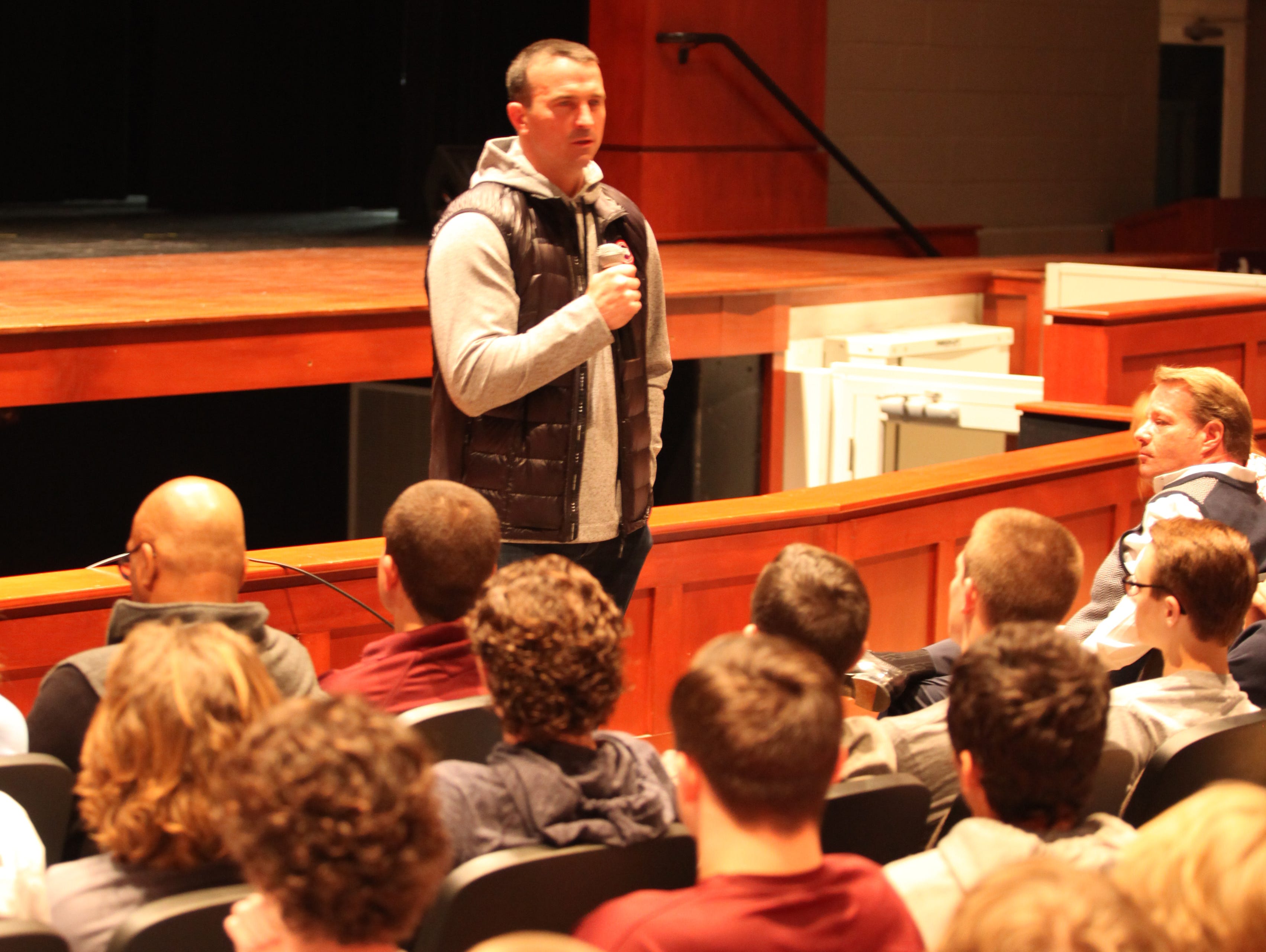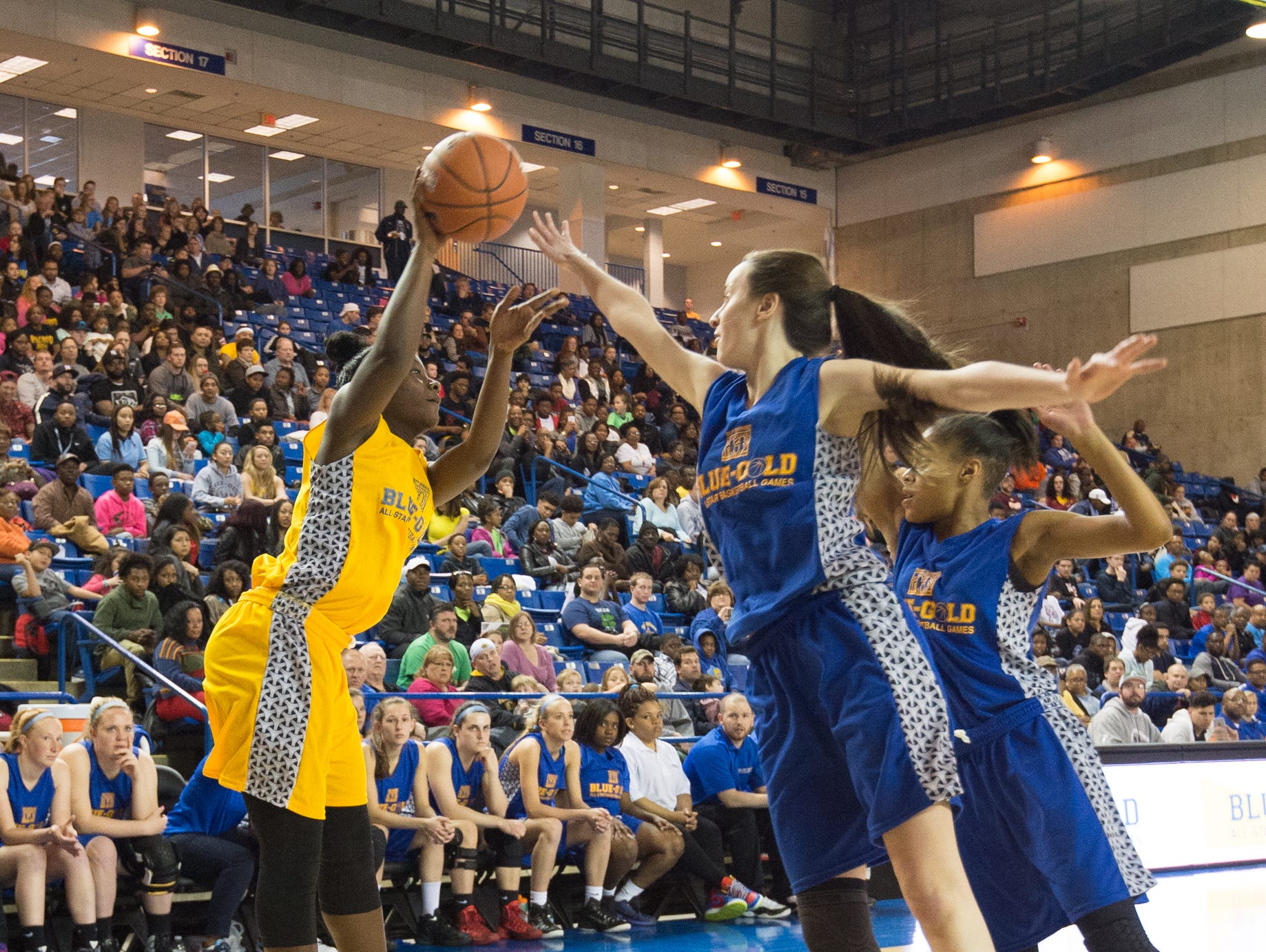![The Louis L. Redding House is located on East 11th Street in Wilmington.]()
The Louis L. Redding House is located on East 11th Street in Wilmington.
![P.S. du Pont 1968 state championship basketball team members (L-R) Ronnie Smith, Clinton Tynes and Randy Johnson with a Morning News picture page from their state-title win. On the other side was a Ku Klux Klan ad.]()
P.S. du Pont 1968 state championship basketball team members (L-R) Ronnie Smith, Clinton Tynes and Randy Johnson with a Morning News picture page from their state-title win. On the other side was a Ku Klux Klan ad.
![Former 1968 state championship basketball teammates Bobbie Dillard, Dennis Spivack, Ron Smith and Andy Berger, reunited in front of the old P.S. du Pont High School where they all once played.]()
Former 1968 state championship basketball teammates Bobbie Dillard, Dennis Spivack, Ron Smith and Andy Berger, reunited in front of the old P.S. du Pont High School where they all once played.
![Randy Johnson gives a big hug to his former 1968 basketball teammate Ron Smith in front P.S. du Pont High School.]()
Randy Johnson gives a big hug to his former 1968 basketball teammate Ron Smith in front P.S. du Pont High School.
![Former 1968 state championship basketball teammates Randy Johnson, Clinton Tymes, and Ron Smith share laughs while looking at their old class photographs in front of the former P.S. du Pont High School.]()
Former 1968 state championship basketball teammates Randy Johnson, Clinton Tymes, and Ron Smith share laughs while looking at their old class photographs in front of the former P.S. du Pont High School.
They were teammates at P.S. du Pont High who often competed with or against each other on basketball courts there or at nearby Haynes Park in the 1960s.
It was a mixture of black kids and white kids from surrounding Wilmington neighborhoods, teenagers who never believed racial differences divided them.
“We all wax poetically about our time at P.S.,” said Randy Johnson, who described it as almost a “Camelot” adolescence.
“We were all very friendly. You didn’t see racially motivated fights. We were all real good friends.”
And they remained close, which is why, one-half century later, a group of about 10 former P.S. du Pont student-athletes has launched an effort to honor the man whose vision for desegregated schools brought – and kept — them together.
![(back row left to right) Hammond Knox, Alton "Butch" Williams, David Spencer, Andy Berger, and Clinton Tymes. (bottom left to right) Ron Smith, Randy Johnson, Bobbie Dillard and Dennis Spivack, all members of the 1968 P.S. du Pont High state championship boys basketball team. They have recently become involved in the Louis Redding House Foundation, a non-profit group that recognizes the efforts of the first African-American attorney from Delaware.]()
(back row left to right) Hammond Knox, Alton "Butch" Williams, David Spencer, Andy Berger, and Clinton Tymes. (bottom left to right) Ron Smith, Randy Johnson, Bobbie Dillard and Dennis Spivack, all members of the 1968 P.S. du Pont High state championship boys basketball team. They have recently become involved in the Louis Redding House Foundation, a non-profit group that recognizes the efforts of the first African-American attorney from Delaware.
Louis L. Redding became Delaware’s first African-American lawyer in 1929 and was the racially segregated state’s only one well into the 1950s. In 1954, he argued the Delaware case that was part of the landmark Brown v. Board of Education Supreme Court ruling that determined separate schools for black and white students, as existed in Delaware, were unconstitutional.
The Louis L. Redding House Foundation is a non-profit organization that aims to maintain the house as a community center and museum for civil-rights-related endeavors. The Redding House is on 11th Street, having been moved there from its original location on 10th Street, where it might have been razed because of commercial development. It was the boyhood home of Redding, who died in 1998 at age 96.
“I said to David, ‘If it were not for Louis L. Redding and his efforts and his argument before the Supreme Court and the Brown v. Board of Education decision, I wouldn’t even know you. We would have been in separate high schools,’ ” Alton “Butch” Williams, a Wilmington optometrist who graduated from P.S. du Pont in 1967, said of a conversation with P.S. classmate David Spencer. Williams had recently become a foundation board member.
“Never the two shall meet,” Williams added. “And then we looked back on all the guys we grew up with – black and white and Jewish – and then we all knew each other, we loved each other, we worked together well. There was never a problem. We didn’t realize until later in life the impact Louis Redding had on all of our lives and that’s why we want to tie in with the foundation, bring attention to it and assist any way we can to help maintain his legacy.”
Williams hopes to do that by encouraging efforts that will shed light on Redding, the Redding House and Redding’s impact on civil rights and, he hopes, inspire citizens. Ideas include group tours of the Redding House and other ventures involving history and education, creating a scholarship fund to aid inner-city students and developing school mentoring programs. Johnson, for example, already teaches money-management classes for young adults.
![Former P.S. du Pont High student-athletes look at a 1968 Morning News with a Ku Klux Klan ad in the lower left corner. On the other side was a picture page from their state basketball title.]()
Former P.S. du Pont High student-athletes look at a 1968 Morning News with a Ku Klux Klan ad in the lower left corner. On the other side was a picture page from their state basketball title.
The recent death of a Howard student, 16-year-old Amy Inita Joyner Francis, after a restroom assault inside the Wilmington high school, “crystallized,” said Williams, the need for educational and enrichment programs within the black community.
The Rev. J.B. Redding, the civil-rights icon’s daughter and a foundation board member, said discussions with how the P.S. du Pont group can help are “at a very preliminary stage” and still taking shape.
“They came to us with great enthusiasm and some very good ideas but we’re not at a point yet where we can talk with any clarity about what we’re going to do,” said J.B. Redding . “We’re happy and excited with these fresh ideas.”
Redding added that the goals of the foundation are to “expose people to some of the Delaware-based civil rights history” through the Redding House and her father’s unique family background. The foundation does not yet have a website and the house/museum does not feature regular tour hours, but it does have a Facebook page. Additional fund-raising is also necessary, she said, as board members fine tune the foundation’s objectives and make the house/museum more of an epicenter for civil-rights education and history.
Dennis Spivak, a 1965 P.S. grad who describes his time there as “magical,” was particularly inclined to get behind an effort recognizing Redding’s impact.
An attorney, Spivak “had the high honor and privilege,” he said, of working alongside Redding on some of his early cases while working in the state Attorney General’s office.
“He would tell me what I did right, what I did wrong, and I’m thinking, This is Louis Redding,” Spivak recalled. “I felt his presence. He had a quiet strength about him. I was so fortunate.”
Spivak felt Redding’s ideals were represented in the way he and his classmates and teammates related.
“It should have been the model of what desegregation was to be,” he said. “People should have come to look and see how we did it. Times change, but I always looked at it as kind of the golden age of our school, the way people spoke to each other with respect.’’
Ironically, it was court-ordered desegregation that caused P.S. to stop being a high school in 1978, when the effort began to bus Wilmington students to suburban schools for better racial balance.
P.S. still stands and is filled with students. Now a Brandywine School District middle school, its picture-postcard appearance, with the Georgian-style brick facade and cupola-topped tower, still draws ogles, even from those who’ve spent a lifetime admiring it.
“I recruited all over the country and this is the most beautiful school I ever saw,” said Spencer, who was a college basketball coach for more than 30 years, including stints as head coach at California-Riverside and an assistant at Southern California. “Look at it. It’s gorgeous.”
A championship irony
Standing in front of P.S. during a recent sunny, windy afternoon, Johnson pulls a tattered, yellowed newspaper page out of the trunk of his car.
It’s the Morning News – a News Journal predecessor – from Monday, March 18, 1968, two days after P.S. du Pont downed Newark 81-65 for the state boys basketball championship in front of 3,420 at the Delaware Field House
On one side is a picture page. There are six photographs. One features Johnson — in delighted, disheveled disbelief — wearing the net, clipped from rim, around his neck. In those pictures are black players and white, vying for one of the state’s prized championships.
In comparison, what’s on the other side of that sports page seems rather incongruous.
Tucked in the lower left corner, covering 10 column inches, is an advertisement for the Ku Klux Klan, which is basically attempting to refute recent reports of its demise. “The Klan lives,” it claims. A New Castle office mailing address is included.
Clinton Tynes, an African-American who played on that team, shakes his head at the sight of it.
!["That might as well be me," said Alton Williams as he pointed to the young boy in the statue alongside Louis L. Redding outside the City/County Building in Wilmington that bears his name.]()
"That might as well be me," said Alton Williams as he pointed to the young boy in the statue alongside Louis L. Redding outside the City/County Building in Wilmington that bears his name.
“It was still out there,” he said of the racial divide gripping the U.S. in 1968. “But none of us ever came here with any animus.
“Throughout my life, I’ve been in situations where I’ve been the only African-American in the room and, because of my experience [at P.S.], I’ve never been intimidated by that.”
Many of the white students who attended P.S. lived in neighborhoods closer to the school, located at 701 W. 34th Street. Some of the black students lived farther away, east of Market Street or as far away as Gov. Printz Blvd, such as Tynes, Williams and Ronnie Smith.
“I used to walk two miles to school,” said Smith, who also played on P.S.’s 1968 state championship basketball team. “What bonded us all together was we all played sports.”
Andy Berger, a white student, grew up near the corner of 34th and Van Buren Street, directly across from the wide front steps of P.S. Though his family moved and he attended his last two years of high school a few miles north at Mount Pleasant, he remained close with the P.S. du Pont group with which he’d grown up.
“We met at such a great time,” he said. “We had common interests and the friendships and fellowship followed. This was certainly a transitional period in the state of Delaware that everybody was going through. But we didn’t feel it. We played basketball, even on winter days when it was 16 degrees and we had to use ice picks to clear the court.”
Less than three weeks after P.S. won that state championship, the Rev. Martin Luther King was assassinated in Memphis, Tennessee.
Riots in Wilmington led to the National Guard patrolling the city until the following January, the longest such occupation of a U.S. city by American forces since the Civil War. It brought considerable embarrassment to the city and stoked racial divisions, said Williams, who was a University of Delaware student at the time.
“There was a period of time in the 1960s when we came together and then it fell apart again,” he said. “It’s taken a long time to repair that thing. What we’re doing goes a long way toward mending that. That we stayed together shows it can be done.
“It’s a real neat history,” Williams added. “We knew each other and we loved each other and we respected each other right to this day. It all started from that seed: We’re not going to take this separate-but-equal doctrine as gospel. It’s not gospel. It’s evil actually. We wanted to change that and that’s what Louis Redding did.”
Contact Kevin Tresolini at ktresolini@delawareonline.com. Follow on Twitter @kevintresolini.


























































